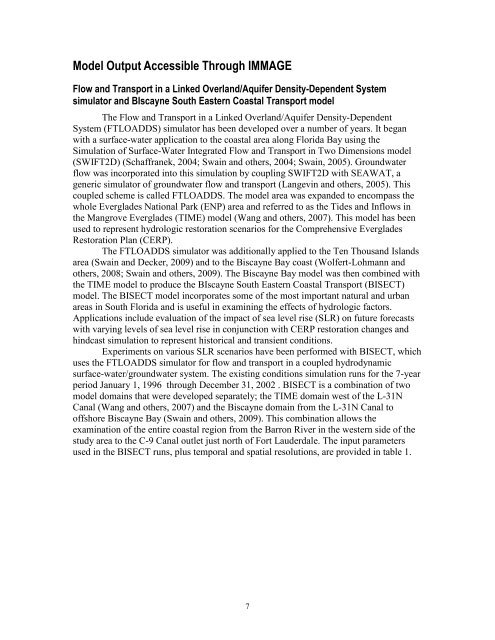Report PDF (3.7 MB) - USGS
Report PDF (3.7 MB) - USGS
Report PDF (3.7 MB) - USGS
Create successful ePaper yourself
Turn your PDF publications into a flip-book with our unique Google optimized e-Paper software.
Model Output Accessible Through IMMAGE<br />
Flow and Transport in a Linked Overland/Aquifer Density-Dependent System<br />
simulator and BIscayne South Eastern Coastal Transport model<br />
The Flow and Transport in a Linked Overland/Aquifer Density-Dependent<br />
System (FTLOADDS) simulator has been developed over a number of years. It began<br />
with a surface-water application to the coastal area along Florida Bay using the<br />
Simulation of Surface-Water Integrated Flow and Transport in Two Dimensions model<br />
(SWIFT2D) (Schaffranek, 2004; Swain and others, 2004; Swain, 2005). Groundwater<br />
flow was incorporated into this simulation by coupling SWIFT2D with SEAWAT, a<br />
generic simulator of groundwater flow and transport (Langevin and others, 2005). This<br />
coupled scheme is called FTLOADDS. The model area was expanded to encompass the<br />
whole Everglades National Park (ENP) area and referred to as the Tides and Inflows in<br />
the Mangrove Everglades (TIME) model (Wang and others, 2007). This model has been<br />
used to represent hydrologic restoration scenarios for the Comprehensive Everglades<br />
Restoration Plan (CERP).<br />
The FTLOADDS simulator was additionally applied to the Ten Thousand Islands<br />
area (Swain and Decker, 2009) and to the Biscayne Bay coast (Wolfert-Lohmann and<br />
others, 2008; Swain and others, 2009). The Biscayne Bay model was then combined with<br />
the TIME model to produce the BIscayne South Eastern Coastal Transport (BISECT)<br />
model. The BISECT model incorporates some of the most important natural and urban<br />
areas in South Florida and is useful in examining the effects of hydrologic factors.<br />
Applications include evaluation of the impact of sea level rise (SLR) on future forecasts<br />
with varying levels of sea level rise in conjunction with CERP restoration changes and<br />
hindcast simulation to represent historical and transient conditions.<br />
Experiments on various SLR scenarios have been performed with BISECT, which<br />
uses the FTLOADDS simulator for flow and transport in a coupled hydrodynamic<br />
surface-water/groundwater system. The existing conditions simulation runs for the 7-year<br />
period January 1, 1996 through December 31, 2002 . BISECT is a combination of two<br />
model domains that were developed separately; the TIME domain west of the L-31N<br />
Canal (Wang and others, 2007) and the Biscayne domain from the L-31N Canal to<br />
offshore Biscayne Bay (Swain and others, 2009). This combination allows the<br />
examination of the entire coastal region from the Barron River in the western side of the<br />
study area to the C-9 Canal outlet just north of Fort Lauderdale. The input parameters<br />
used in the BISECT runs, plus temporal and spatial resolutions, are provided in table 1.<br />
7
















